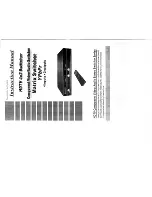
8. Performance > Performance Monitoring
190
Tsi578 User Manual
June 6, 2016
Integrated Device Technology
www.idt.com
The following sub-sections describe the use of these parameters for monitoring the performance of the
serial RapidIO ports in Tsi578.
8.2.1
Traffic Efficiency
To characterize the efficiency of system traffic, the following parameters are used:
1.
Packet rate (number of packets / time)
— Packet rate is calculated using the number of packets computed from a counter register
configured to count the number of packets.
2.
Average packet size (number of 32-bit words / number of packets)
— Average packet size is calculated using a counter configured to count the number of 32-bit
words (call it COUNTER A), and a counter configured to count the number of packets (call it
COUNTER B). The average packet size is COUNTER A divided by the value in
COUNTER B.
3.
Utilization ((packet rate * packet size) / max capacity)
— Utilization is calculated using parameter 1 and parameter 2, above.
These values are derived from the number of packets and the number of 32-bit words on each interface.
The calculations of the packet rate, packet size, and utilization are completed externally.
8.2.2
Throughput
The count of packets per priority in each interface can be a very important parameter when debugging
RapidIO systems. This information can also be valuable when used by system software to dynamically
re-route traffic around congested interfaces. The following parameters are used to monitor the
throughput on each RapidIO interface:
•
Number of packets for each priority level (0, 1, 2 and 3)
— Each performance counter register (for example,
“RapidIO Port x Performance Statistics
Counter 0 Register” on page 344
) can be configured to count the number of packets selected
based on priority.
Retried packets are not counted.
















































